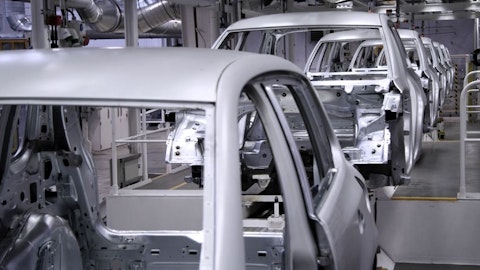Robert Mack: I mean, we’ll see the bulk of the segment gross margin improvement will be in Off-Road because the two factories that have been underperforming are really our Monterrey and our two large factories. And so those are primarily focused on Off-Road. So you’ll see the bulk of that in Off-Road. In On-Road, it’s a pretty flat year. Indians continued to focus on margin. It will mostly depend on what the kind of heavyweight versus midsized mix looks like, and that will just depend on how the industry plays out. But obviously, heavyweights carry a little more gross margin than midsize. And then in marine, we’ll — they’re continuing to do a really nice job of managing margins given lower shipments. And the great thing about that business is it’s a pretty variable cost structure.
So we’ve been able to get at the cost structure to help maintain overall EBITDA margins, even though gross margins were a little bit down. So I think you’ll see where most of the improvement comes is in Off-Road.
Tristan Thomas-Martin: Okay, thank you. And then just one more. Given the XD 1500 XPEDITION, the initial shipment, I think was pushed a little bit later than you thought. Is there a chance that ’24 shipping for this new kind of unannounced product is actually higher than the incremental new product shipping in ’23?
Michael Speetzen: Yes. I mean it’s tough to say. I mean, I think the opportunity we have with XD and XPEDITION given the positive reception, I suspect that that’s going to be — if you think about those are not completely, but highly incremental. In terms of new segments, we certainly will cannibalize some customers off of general for XPEDITION and the core Ranger business for XD. But given the bulk of that is incremental, it’s probably going to outpace any other potential new products that we would have just given the size of those markets.
Robert Mack: Yes, there’ll be a little bit of we weren’t shipping XPEDITIONS pretty well in Q4. There’ll be a little — there’ll be some incremental on XPEDITION. But then as Mike said, most of XD will be incremental to the XD that shipped in 2023, which was pretty low.
Tristan Thomas-Martin: Okay, thank you.
Operator: Thank you. The next question is from Sabahat Khan with RBC Capital Markets. Please go ahead.
Sabahat Khan: Great, thanks. And good morning. Just I guess, maybe going back to the margin side, but more on the promotional angle, I’m obviously taking into account that you do have a bit of cost savings in this gross margin expectation. What kind of competitor promotional activity are you baking into this number? Sort of what did you underwrite in terms of your ’24 guidance, could folks get a bit more aggressive to clean up inventory? And how would you respond to that in market? Thanks.
Robert Mack: Yes. I think what we’re expecting, as Mike said in his remarks, we saw some competitors had a fair amount of ’23 model year carryover. Our inventory was cleaner. That really ramped up the promotional spend, and we had to respond, even though we had current inventory, we had to respond to not lose share to people buying ’23 with a lot of [indiscernible] that was effective in Q4. That inventory is winding down. So we expect that ’23 versus ’24 dynamic to start to abate in Q1. But like we said, we do think Q1 first of all, we’re lapping a kind of a low promo quarter because we had all the channel fill in Q1 of last year. So promos across the industry, we’re the lowest point of 2023 in Q1. So we’re lapping that with Q4, which was the most aggressive.
As it plays through the year, I think as Mike said, we’re — many of our competitors in the industry are having the same message we are that we’re going to try to keep dealer inventory at reasonable levels in retail and take some dealer inventory out through the course of the year. I think based on kind of what we’ve seen so far, it looks like people are all following a similar path to us that they’ll be pretty conservative with shipments in the early part of the year, which should help the inventory be in a better position across the space as we get into the second quarter. So we’re planning on promo being relatively in line with this year, and it’s going to be highly dependent on what happens to dealer inventory.
Sabahat Khan: Great. And then I guess just one on just kind of the overall industry dynamics. One of the questions we’ve been getting with the industry softness over the last, call it, three to four months, could ’24 be sort of a step backwards towards industry volumes pre-pandemic? Is there some sort of a broad industry normalization happening in units and/or margins. Just want to get, I guess, from your vantage point, you did call out that most of the weakness this year is going to be in Q1 and then normalization. How do you view sort of overall industry volumes, what do you consider to be normal for your unit volumes as well as margins? Just any perspective on what you’re hearing from dealers and seeing out there?
Michael Speetzen: Well, I mean, like I said in my prepared remarks, we anticipate the industry is going to be down and for some reason, I think there’s been a view that the industry got some massive uptick as it related to what happened with COVID. And essentially, if you go back in time, really, what happened was we had a year where just a ton, not just assuming the industry everything was sold off of dealers’ floors and then we’ve spent the last few years just trying to get caught up. So with industry being down a little bit next year, we think that the volumes are still hovering at or below where they’ve been historically. And from my standpoint, it’s really two things that are going to have to get resolved. I think the uncertainty around the economy as it relates to our discretionary products, the rec products, marine, things like that as well as interest rates.
I mean, look people — even though the financing isn’t — the impact of the interest rates isn’t some significant monthly impact to their payment, people just generally don’t want to finance at the top of the market. And so we do think that you can see it every time the Fed talks about or hints at what they’re going to do with interest rates, you see things start to shift. And I think once the rates do start to move, I think that is going to be positive for the industry, people want to be in. We’re not seeing some surge of used vehicles where people are just saying, “Hey, we want out.” One of the interesting facts that we’ve seen, we’ve talked about it in prior calls, we track repurchase rates. Everything from customers who bought some three months ago to people who were in the market a year ago, five years ago, 10 years ago.
And those repurchase rates actually got stagnant during the pandemic surge because new people coming into the category were willing to pay a lot for vehicles. And what we’ve seen is since that fever has kind of lowered the repurchase rates pretty much across every category we track had actually started ticking back up. And I think that’s good for the industry because we know that people are out there. They’ve got aging product. We’ve got a ton of new product and innovation out in the marketplace. And I think we just need to see some things settle out during ’24, and I’m optimistic as we get out of ’24, the setup is much better heading into ’25, both for us as a company as well as potentially for the industry.




